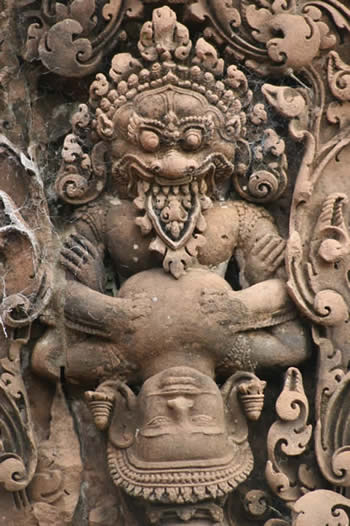
Buffers and Kundabuffer |
Buffers, as described by G. when he was educating O, are very specific mechanisms "unique" to each individual which insulate them from the realities of their manifestations. One of the specific examples cited, if I recall correctly, was one in which a man believed he was always on time. As a consequence of his buffer, this man could be late all he liked and never know or admit it.
As such, the concept of "buffers" bears a striking resemblance to contemporary understandings of denial mechanisms. Speaking as a longtime recovering alcoholic, I can say with some confidence that these mechanisms are enormously powerful and operate in many areas other than just those surrounding addictive behaviors. For example- I was in a violent, abusive marriage for years and developed an intense buffer around it which I never saw the "other side" of until after the divorce. Then it shocked me a great deal, because I had never seen it at all when married. This despite years of serious personal abuse, both physcial and emotional.
This ubiquitous invisibility is a characteristic feature of our buffers. It's very reminiscent of G's description of Chief feature, which is said to be equally impenetrable and invisible to a man. We might infer here that buffers protect Chief Feature. That is to say, there is a group of ideas or opinions within us constructed to absolutely prevent us from seeing how we are. The tricky part of it is that most of what we see and believe is constricted by buffers.
As to kundabuffer. Here we have an organ, that is, a physical structure, that causes man to not see himself. In "Beelzebub," the effect it is said to have had is to cause man to derive pleasure from repeated associations or events. We might infer from this that it induced a form of hypnosis where repetitive events became desirable. Habits are formed and reinforced.
This is reminscent of pavlovian mechanisms and implies a relatively robotic relationship to life events.
I offer the Pavlovian comparison quite deliberately. We are literally "dogs." The classic Koan "Does the dog have Buddha nature?" is the essential question of what we are. We do not even know we are the dog, the habitual, pleasure-seeking robot of associations. Man is not Plato's prisoner, the dog is- and at best all we ever see is the dog's shadow, rather than the dog itself- so we are unable to know anything whatsoever about the dog's nature.
Our buffer-fed hypnosis functions to prevent us from gaining a true view of our life because of these repetitive patterns of behavior. We do not crave "no place to rest our heads"- we crave predictability. Hence G's admonitions to do everything possible to avoid the predictable course- to "not do things as others do them." This path has strong parallels in Zen tradition where extreme spontanaeity is seen as direct evidence of liberation.
In the original version, Kundabuffer was an organ, a physical structure, but today we generally understand denial to be a mainly psychological mechanism. No coincidence- this is consistent with G's contention that the physical presence and action of the organ kundabuffer was supplanted by a psychologicalone. In inner works, we often encounter the understanding that the malady of human delusion is one produced by excessive reliance on the mind and its machinations.
Hence we arrive at the suggestion that buffers would be, essentially, the children of Kundabuffer. To take it one step further:
--Kundabuffer brought upon mankind a collectively induced and naturally lawful delusion, for which he could not be held directly responsible.
--Buffers confer upon man self-inflicted and unqiuely individual obstacles which he canattempt to take responsibility for
-if he wishes to.